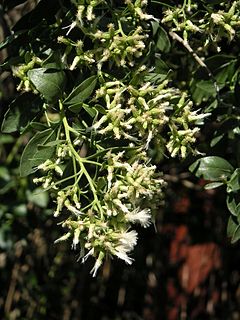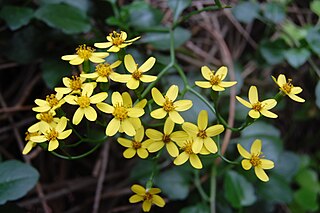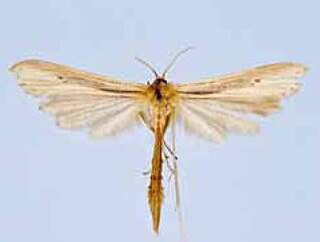
Senecio is a genus of the daisy family (Asteraceae) that includes ragworts and groundsels. The scientific Latin genus name, Senecio, means "old man."

Yuraygir is a national park in New South Wales, Australia, located 482 km (300 mi) northeast of Sydney. It was created in 1980, a result of the merger and enlargement of two national parks, Angourie and Red Rock National Parks, both of which had been established in 1975. At the time of its establishment in 1980, the park was fragmented, and parcels of land were bought over the following two decades to unite segments into a more contiguous protected area. Sometimes these acquisitions required protracted negotiations with land owners.

Senecio vulgaris, often known by the common names groundsel and old-man-in-the-spring, is a flowering plant in the daisy family Asteraceae. It is an annual herb, native to Europe and widely naturalised as a ruderal species in suitable disturbed habitats worldwide.

The Pterophoridae or plume moths are a family of Lepidoptera with unusually modified wings. Though they belong to the Apoditrysia like the larger moths and the butterflies, unlike these they are tiny and were formerly included among the assemblage called "microlepidoptera".

Baccharis is a genus of perennials and shrubs in the aster family (Asteraceae). They are commonly known as baccharises but sometimes referred to as "brooms", because many members have small thin leaves resembling the true brooms. They are not at all related to these however, but belong to an entirely different lineage of eudicots. B. halimifolia is commonly known as "groundsel bush", however true groundsels are found in the genus Senecio.

Baccharis pilularis, called coyote brush, chaparral broom, and bush baccharis, is a shrub in the daisy family native to California, Oregon, Washington, and Baja California. There are reports of isolated populations in New Mexico, most likely introduced.

Nepticulidae is a family of very small moths with a worldwide distribution. They are characterised by eyecaps over the eyes. These pigmy moths or midget moths, as they are commonly known, include the smallest of all living moths, with a wingspan that can be as little as 3 mm in the case of the European pigmy sorrel moth, but more usually 3.5–10 mm. The wings of adult moths are narrow and lanceolate, sometimes with metallic markings, and with the venation very simplified compared to most other moths.

Baccharis halimifolia is a North American species of shrubs in the daisy family. It is native to Nova Scotia, the eastern and southern United States, eastern Mexico, the Bahamas, and Cuba.

Baccharis sarothroides is a North American species of flowering shrub known by the common names broom baccharis, desertbroom, greasewood, rosin-bush and groundsel in English and "escoba amarga" or "romerillo" in Spanish. This is a spreading, woody shrub usually sticky with glandular secretions along the primarily leafless green stems. The small, thick leaves are a few centimeters long and are absent much of the year, giving the shrub a spindly, twiggy appearance. It flowers abundantly with tiny green blooms on separate male and female plants.
Groundsel is a common name for several plants and may refer to:

Senecio angulatus also known as creeping groundsel and sometimes as Cape ivy is a climbing succulent perennial from the family Asteraceae of the genus Senecio; a native of South Africa an alien in Australia, a problem weed in New Zealand, naturalized in North Africa, and cultivated elsewhere.

Senecio pinnatifolius is a species of herb native to Australia. Common names include coast groundsel, dune groundsel and variable groundsel.

Cucullia oribac is a moth of the family Noctuidae first described by William Barnes in 1904. It is found in Mexico and the southwestern United States. In the United States, it is found in the mountains of southern Arizona, north to Gila County. It is also found in southwestern New Mexico, and the Guadalupe Mountains in western Texas. In Mexico, it is known from the Federal District, Veracruz, Morelos and Chiapas.
Lioptilodes albistriolatus is a moth of the family Pterophoridae. In South America and Central America it has been recorded from Argentina, Brazil, Chile, Costa Rica, Cuba, Ecuador, Guatemala, Paraguay, Peru and Puerto Rico. It is also present in North America, where it is known from Mexico, California, Texas, New Mexico and Arizona. It is an introduced species in Hawaii.

Hellinsia balanotes, the baccharis borer, is a moth of the family Pterophoridae which is native to Guatemala, northern Mexico, and the United States including Arizona, Texas, Florida, Mississippi, South Carolina and Maryland, but has been introduced to Australia for the control of Baccharis halimifolia. The species was first described by Edward Meyrick in 1908.

Cremastobombycia solidaginis is a moth of the family Gracillariidae. It is known from Quebec in Canada and Florida, Texas, Georgia, Kentucky, Maine, Maryland, Massachusetts, Connecticut and Michigan in the United States.

Synchlora gerularia is a moth in the family Geometridae. It is found from Texas in the southern United States through Central America to Argentina in South America. It is also found on the Antilles.
Lorita baccharivora, the groundsel leafroller, is a species of moth of the family Tortricidae. It is native to Florida and Texas, but has been introduced to Australia for the biological control of groundsel bush.
Prionoxystus piger, the baccharis carpenterworm moth, is a moth in the family Cossidae. It was described by Augustus Radcliffe Grote in 1865. It is found in Florida and Cuba.
Coleotechnites bacchariella, the coyote brush twig borer moth, is a moth of the family Gelechiidae. It is found in the United States, where it has been recorded from California.












